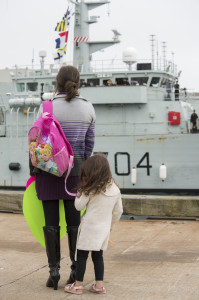
©DND 2014
Photo: LS Peter Frew, Formation Imaging Services Halifax
Upon completion of their deployments in the Canadian Arctic, Her Majesty’s Canadian Ships (HMCS) Kingston and Shawinigan returned to their home port of Halifax.
The ships worked closely with government partners and allied nations to continue a presence in the Canadian Arctic and demonstrate sovereignty.
HMCS Shawinigan began its northern operations by participating in Operation NANOOK, the largest of many operations in Canada’s North. The Canadian Armed Forces focus is multi-faceted: to demonstrate sovereignty by continued operations in Canada’s remote northern regions; to maintain awareness of activity in the Arctic; and to contribute to the safety and security of Canadians by supporting federal, territorial, municipal, and aboriginal authorities.
The ship supported all marine operations on Operation NANOOK, ferrying personnel and equipment ashore and to various other vessels.
Following Shawinigan’s participation in Operation NANOOK, the ship supported the Community Day in Iqaluit where they anchored in the harbour and conducted tours for community elders, town council members and the Commander of Joint Task Force North, Brigadier-General Greg Loos. The ship was later opened to the public and 130 residents toured the ship.
HMCS Shawinigan then broke a Royal Canadian Navy (RCN) record by transiting further north than any modern warship, reaching a northern most latitude of 80 degrees 28 minutes north.
“Having a professional, highly trained and well-motivated Ship’s Company was the key to our success working under the demanding conditions of the Artic environment and breaking an RCN record,” said Lieutenant-Commander Frank Campbell, Commanding Officer of HMCS Shawinigan.”
The presence of the Shawinigan reinforced existing partnerships with the Canadian Coast Guard, Royal Canadian Mounted Police and Environment Canada and furthered an ongoing cooperation with American and Danish allies.
HMCS Kingston was tasked to support the Canadian Hydrographic Service by mapping the ocean floor in the Canadian Arctic and assisting with the search for the ships lost during the 19th century Franklin Expedition. Upon arriving in the Arctic, they hosted Prime Minister Stephen Harper for two days as part of his annual Northern Tour.
“The Ship’s Companies of HMCS Kingston and Shawinigan served well as members of a multi-disciplinary team, multi-agency Government of Canada network and public-private partnership that was key to the RCN developing a deeper understanding of, and capacity for sovereign operations in the North,” said Rear-Admiral John Newton, Commander of Maritime Forces Atlantic and Joint Task Force Atlantic.
Kingston made significant contributions to the expedition by working with a Canadian Hydrographic Service expert to survey over 645 squared nautical miles. The information and data received from the expedition provides significant value for Canada.
“Aiding in the hydrographic surveys was important to the success of the operation. We were able to survey previously uncharted areas such as Erik Harbour and other northern communities to support our government partners,” said Lieutenant-Commander Paul Smith, Commanding Officer of HMCS Kingston.
The ships’ contributions to CAF operations in the North were a success. The hydrographic, bathymetric and geographical information collected is key to making the internal waters a safe environment for increasing commercial activities, shipping, tourism and recreation.
The RCN’s accomplishments in the Arctic were successful in building a deeper understanding of the northern environment and culture which highlights the abundant value of the Canadian North.